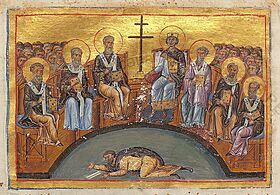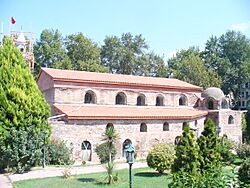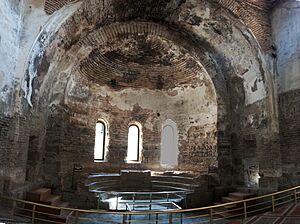Second Council of Nicaea facts for kids
Quick facts for kids Second Council of Nicaea |
|
|---|---|
 |
|
| Date | 787 |
| Accepted by | |
|
Previous council
|
|
|
Next council
|
|
| Convoked by | Constantine VI and Empress Irene (as regent) |
| President | Patriarch Tarasios of Constantinople, and legates of Pope Adrian I |
| Attendance | 308 bishops, 350 members total (including two papal legates) |
| Topics | Iconoclasm |
|
Documents and statements
|
veneration of icons approved |
| Chronological list of ecumenical councils | |
The Second Council of Nicaea was a very important meeting for the Christian Church. It is seen as the last of the first seven major church councils by the Eastern Orthodox Church and the Catholic Church. Other groups like the Old Catholic Church also recognize it. However, Protestant churches have different views on it.
This council took place in 787 CE in Nicaea, which is now called İznik in Turkey. Its main goal was to bring back the use and respect for icons. Icons are holy images used in churches. These images had been banned by the emperor in the Byzantine Empire.
Contents
Why the Council Happened
For many years, there was a big disagreement in the Byzantine Empire about holy images, called icons. This period is known as Byzantine Iconoclasm. Some people believed that using icons was wrong, like worshipping idols. Others believed that icons helped them connect with God and saints.
Emperor Leo III started banning icons in the early 700s. His son, Emperor Constantine V, continued this ban. Constantine V even held a council in 754 AD, called the Council of Hieria, which supported banning icons. This council claimed to be the seventh ecumenical council, but it was later rejected because the main church leaders from other areas were not there.
Emperor Constantine V was very strict about the ban. He even punished people who used icons and many monks. Some people thought the emperor was trying to make his own power seem more important than the power of saints and bishops.
After Emperor Leo IV (Constantine V's son) died, his wife, Empress Irene of Athens, became the ruler for her young son. Empress Irene wanted to bring icons back. She believed they were important for faith.
In 784, a man named Patriarch Tarasius became the new leader of the church in Constantinople. He agreed to take the job only if the church could reunite and bring back the use of icons. Since a previous council had banned icons, a new major council was needed to officially bring them back.
Pope Adrian I from Rome was invited to join the council. He was happy to help and sent his own representatives to the meeting.
The council first tried to meet in Constantinople in 786. But soldiers who were against icons broke up the meeting. So, the government came up with a plan. They sent the anti-icon soldiers away from the capital.
The council was then called to meet again, this time in Nicaea. This was because Constantinople was still not safe enough. The council gathered on September 24, 787, at the Hagia Sophia church in Nicaea. About 350 people attended, including 308 bishops or their representatives. Patriarch Tarasius led the meetings.
What Happened at the Council
The council held seven main meetings in Nicaea. Here are some of the key things that happened:
- First Meeting (September 24, 787): They discussed if bishops who had supported the icon ban could stay in their positions.
- Second Meeting (September 26, 787): Letters from Pope Adrian I were read. These letters supported the use of images but also criticized some actions of the Byzantine Empire. The bishops agreed with the Pope's message.
- Third Meeting (September 28, 787): Representatives from other major church areas presented their papers. It became clear that their leaders had not actually sent them.
- Fourth Meeting (October 1, 787): The council looked at passages from the Bible and writings from early church leaders. They used these to show that respecting icons was allowed and good.
- Fifth Meeting (October 4, 787): More writings were read. These writings aimed to show that the idea of banning icons came from non-Christian groups or heretics.
- Sixth Meeting (October 7, 787): The council read the decisions of the earlier council that had banned icons (the Council of Hieria). They then read a long argument against those decisions.
- Seventh Meeting (October 13, 787): The council made its final statement about holy images.
The council decided that holy images of Jesus Christ, the Virgin Mary, angels, and saints should be used. They said these images could be on church walls, in homes, and in other places.
The council made a very important point:
We should give these images great respect and honor. However, we must not worship them in the same way we worship God. The honor given to an image passes on to the person it represents. So, when you honor an image, you are honoring the holy person shown in it.
This means there's a difference between "veneration" (showing deep respect) and "adoration" (worshipping God alone). Icons are for veneration, not adoration. This helps people understand that they are not worshipping the image itself, but the holy person it represents.
The council also created 22 new rules for the church. These rules focused on keeping the decisions of earlier councils, making sure clergy knew the scriptures, and encouraging good Christian behavior. They also said that every church altar should have a relic (a holy object), which is still a rule in Catholic and Orthodox churches today.
How Different Churches Accepted It
The Pope's representatives fully agreed with the council's decision to bring back icons. The Patriarch sent a full report of the council's meetings to Pope Hadrian I. The Pope officially approved the council's decisions later, in 880.
In Western Europe, some leaders, like Charlemagne, initially disagreed with the council's decisions. They wrote a book called the Libri Carolini against it. However, the Pope disagreed with their arguments. Eventually, the Catholic Church accepted the Second Council of Nicaea as the Seventh Ecumenical Council.
The Eastern Orthodox Church and Eastern Catholic Churches celebrate the final victory over iconoclasm (the ban on icons) every year. This celebration is called "The Sunday of the Triumph of Orthodoxy". It happens on the first Sunday of Great Lent, which is the fasting period before Pascha. They also remember the council itself around October 11.
Many Protestants, especially those who follow John Calvin, do not accept the council's decisions. They believe that using icons, even for veneration, can lead to worshipping idols. They do not agree with the difference between "veneration" and "adoration" that the council made.
Images for kids
See also
- Plato of Sakkoudion
- Sabas of Stoudios
- Fourth Council of Constantinople (Eastern Orthodox)
- Proskynesis





